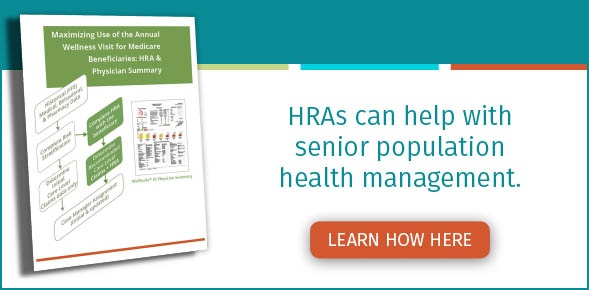An annual wellness visit is a cornerstone to any care plan when it comes to providing health and wellness services to a population. In addition to routine health risk assessments (HRAs), a yearly doctor visit can provide important insight into an individual’s current and future health status.
.jpg?width=375&name=Blog109-Annual-Wellness-Visit%20(1).jpg) However, an annual wellness visit (AWV) can be even more crucial for the Medicare population since health status may change rapidly as individuals age or are living with long-term chronic illnesses. Although life expectancy in the United States has decreased slightly, people are still living well into their 70s and 80s, but they’re as sick as ever – which means they’re just living longer with chronic illnesses or disabilities. And while it’s certainly a good thing to hear that Grandma Jane and Uncle John will be around for many years, it also means that receiving regular care is exceptionally important.
However, an annual wellness visit (AWV) can be even more crucial for the Medicare population since health status may change rapidly as individuals age or are living with long-term chronic illnesses. Although life expectancy in the United States has decreased slightly, people are still living well into their 70s and 80s, but they’re as sick as ever – which means they’re just living longer with chronic illnesses or disabilities. And while it’s certainly a good thing to hear that Grandma Jane and Uncle John will be around for many years, it also means that receiving regular care is exceptionally important.
Since 2011, Medicare has offered an AWV to help promote healthy aging in the senior population. However, this is a population that can be a bit more difficult to reach than others. There may be a variety of reasons for this, such as limited financial resources, limited access to transportation, or simply a reluctance to meet with a physician and hear “bad news.” The benefits of routine, preventive care, however, greatly outweigh the risk of potentially hearing bad news.
These benefits include:
Routine Preventive Care
The primary advantage of annual wellness visits is that issues can be address before they become bigger problems. An individual who is pre-diabetic, for example, will know their risks and be advised on steps to take to get their blood sugar under control. Conversely, a pre-diabetic who never attends their AWV would likely not find out there’s an issue until they’re officially diagnosed with diabetes after being seen for urgent or emergency care.
Screening for Fall Risks
One of the biggest concerns for seniors, especially those living independently, is their fall risk. Unfortunately for our senior population a slip and fall that may be inconsequential to a healthy middle-aged adult could be a life-or-death matter. In fact, every 19 minutes an older adult dies due to injuries sustained during a fall according to the National Council on Aging (NCOA). This is a startling statistic, and one that could be reduced with accurate and timely fall risk screenings. Medicare populations would be asked about falls when they take their annual health risk assessment and be made aware of their fall risks during their AWV. Care providers could suggest take steps a senior could take either independently or with the help of family members or caregivers to reduce their risks and implement preventive measures.
Mental Health Screening
According to the Centers for Disease Control (CDC), 20% of U.S. adults over the age of 55 experience some type of mental health disorder. These disorders range from anxiety and depression to severe cognitive impairment. By attending their AWV, older adults would benefit from mental health screenings that could address concerns and have them receive the proper treatment and medication. Additionally, some medications – especially those used to treat mental illness – affect older populations differently or more profoundly than they do younger populations. For this reason, it is important that all medications are checked annually to ensure proper doses and use.
By addressing these benefits with your Medicare population patients, you will hopefully be able to encourage them to understand the importance of – and attend – their annual wellness visit.
To learn more about practicing value-based care, download our whitepaper, Maximizing Use of the Annual Wellness Visit for Medicare Beneficiaries: HRA and Physician Summary.








